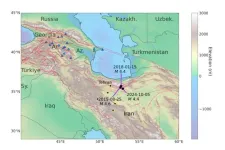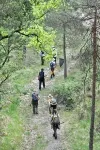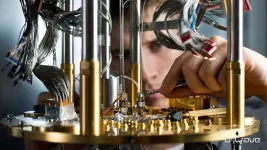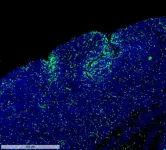(Press-News.org) A new study debunks claims that a magnitude 4.5 earthquake in Iran was a covert nuclear weapons test, as widely alleged on social media and some mainstream news outlets in October 2024, a period of heightened geopolitical tensions in the Middle East.
Led by Johns Hopkins University scientists, the study warns about the potential consequences of mishandling and misinterpreting scientific information, particularly during periods of international conflict. The findings appear in the journal Seismica.
“There was a concerted misinformation and disinformation campaign around this event that promoted the idea this was a nuclear test, which is not something you often see happen with an earthquake,” said Benjamin Fernando, a Johns Hopkins seismologist who led the study. “This shows how geophysical data played an important role in a geopolitical crisis.”
The earthquake occurred on Oct. 5, 2024, approximately 50 kilometers (31 miles) southwest of Semnan, a city in northern Iran, and about 216 kilometers (134 miles) east of Tehran. Iran is prone to earthquakes, as it sits within a seismically active region at the convergence of the Arabian and Eurasian tectonic plates.
Fernando’s team analyzed seismic signals from the event, identifying natural seismic activity caused by the earthquake. Using publicly available data from seismic monitoring stations, the researchers concluded that the earthquake originated along a gently sloping fault where Earth’s crust was being deformed by the collision between Arabia and Eurasia. The process aligns with the geophysical forces that characterize the region’s tectonically active interior and rules out any connection to a particularly unusual source or nuclear test, the study concludes.
“Seismic waves carry information about the earthquake that produced them as they propagate around the planet. By recording the waves at different points on the Earth’s surface, we can work out what the properties of the source that produced them were,” Fernando said. “In this case, the source was what we call a reverse fault—a motion associated with the Earth’s crust being crushed as the Arabian and Eurasian plates collide. Nuclear tests have very different signatures, which are explosive.”
Historical seismic data further supports this conclusion, Fernando said. The Comprehensive Test Ban Treaty Organization (CTBTO), which monitors nuclear tests worldwide, reported that earthquakes with similar characteristics and magnitudes occurred in the same region in 2015 and 2018—both unrelated to nuclear activity.
Despite the clear scientific evidence of natural seismic activity, claims that the earthquake was a nuclear test began spreading rapidly on social media just 17 minutes after the event. Initial tweets misinterpreted seismic data, which soon gave way to misinformation and likely active disinformation, Fernando said.
The first suggestion that this was a nuclear test appeared on Twitter/X 27 minutes after the earthquake. Over the following hours, misinformation escalated, with some posts citing seismic data from an entirely different earthquake in Armenia earlier that day to substantiate the nuclear test narrative.
The misinformation gained traction as conspiracy theories linked the Iranian earthquake to a supposed seismic event in Israel the same evening. While the study noted that it is difficult to confirm deliberate disinformation, the sustained engagement and specialized use of seismology data on social media suggest potential human authors with expertise. One of the most widely shared posts promoting the nuclear test theory came from an account tied to Russian-supported disinformation campaigns, the researchers found.
Within hours of the event, the false narrative moved from social media to news reports worldwide. Indian English-language media were the most active in reporting the nuclear test claims, often referencing each other’s stories, and citing the incorrect seismic data. The researchers also identified media reports from the United States, Israel, Pakistan, Zimbabwe, France, and the United Kingdom.
In contrast, Persian-language media generally described the event accurately as a natural earthquake. These reports drew on local expert commentary and official seismic data more often than English-language media, offering a more precise understanding of the event.
The researchers recommended greater rapid-response collaborations among seismologists to quickly fact-check and correct misinterpretations of data, and to more actively counter misinformation.
“Scientific agencies could issue detailed reports swiftly to counter misinformation,” said co-author Saman Karimi, a Johns Hopkins geophysicist. “Giving amplification to contents coming from verified scientific accounts could help reduce the misleading narrative. This can be done via partnership between social media platforms and trusted seismologists or agencies such as the U.S. Geological Survey.”
Other authors are Ross Maguire of University of Illinois Urbana-Champaign, Brianna Fernandez of Brown University, Elizabeth Koenck of Georgetown University, Göran Ekström of Columbia University, Tom Rivlin of Technische Universität Wien, and Celeste Labedz of University of Chicago.
END
Study debunks nuclear test misinformation following 2024 Iran earthquake
2025-02-04
ELSE PRESS RELEASES FROM THIS DATE:
Quantum machine offers peek into “dance” of cosmic bubbles
2025-02-04
Physicists have performed a groundbreaking simulation they say sheds new light on an elusive phenomenon that could determine the ultimate fate of the Universe.
Pioneering research in quantum field theory around 50 years ago proposed that the universe may be trapped in a false vacuum – meaning it appears stable but in fact could be on the verge of transitioning to an even more stable, true vacuum state. While this process could trigger a catastrophic change in the Universe's structure, experts agree that predicting the timeline ...
How hungry fat cells could someday starve cancer to death
2025-02-04
How Hungry Fat Cells Could Someday Starve Cancer to Death
Scientists transformed energy-storing white fat cells into calorie-burning ‘beige’ fat. Once implanted, they outcompeted tumors for resources, beating back five different types of cancer in lab experiments.
Liposuction and plastic surgery aren’t often mentioned in the same breath as cancer.
But they are the inspiration for a new approach to treating cancer that uses engineered fat cells to deprive tumors of nutrition.
Researchers at UC San Francisco used the gene editing technology CRISPR to turn ordinary white fat cells into “beige” fat cells, which voraciously consume calories to make ...
Breakthrough in childhood brain cancer research could heal treatment-resistant tumors, keep them in remission
2025-02-04
Brain cancer is the second-leading cause of death in children in the developed world. For the children who survive, standard treatments have long-term impacts on their development and quality of life, particularly in small children and infants.
Research out of Emory University and QIMR Berghofer Medical Research Institute in Queensland, Australia, has shown that a potential new targeted therapy for childhood brain cancer is effective in infiltrating and killing tumor cells in preclinical models tested in mice.
In ...
Research discovery halts childhood brain tumor before it forms
2025-02-04
Scientists at The Hospital for Sick Children (SickKids) have discovered a way to stop tumour growth before it starts for a subtype of medulloblastoma, the most common childhood malignant brain cancer.
Brain cancer presents a unique set of challenges for researchers – by the time a person experiences symptoms, the tumours are often so complex that the fundamental mechanisms driving the tumour growth are no longer easy to identify. A research team led by Dr. Peter Dirks is working to combat ...
Scientists want to throw a wrench in the gears of cancer’s growth
2025-02-04
Preventing the cell’s protein factories from making the notorious cancer-causing protein MYC could stop out-of-control tumors.
For decades, scientists have tried to stop cancer by disabling the mutated proteins that are found in tumors. But many cancers manage to overcome this and continue growing.
Now, UCSF scientists think they can throw a wrench into the fabrication of a key growth-related protein, MYC, that escalates wildly in 70% of all cancers. Unlike some other targets of cancer therapies, MYC can be dangerous simply due to its abundance.
In a paper that appears Feb. 4 in Nature Cell Biology, researchers at UC San Francisco ...
WSU researcher pioneers new study model with clues to anti-aging
2025-02-04
SPOKANE, Wash. — Washington State University scientists have created genetically-engineered mice that could help accelerate anti-aging research.
Globally, scientists are working to unlock the secrets of extending human lifespan at the cellular level, where aging occurs gradually due to the shortening of telomeres–the protective caps at the ends of chromosomes that function like shoelace tips to prevent unraveling. As telomeres shorten over time, cells lose their ability to divide for healthy ...
EU awards €5 grant to 18 international researchers in critical raw materials, the “21st century's gold”
2025-02-04
The new EU-funded consortium “ForMovFluid” will study how fluids transformed the materials inside the Earth's crust. Thanks to the Marie Skłodowska-Curie Action Doctoral Networks programme, ForMovFluid will fund the doctoral studies of 18 researchers, and train them to become elite experts in the field of geoscience.
Moreover, this project will allow us to understand the origin of the so-called critical raw materials, of vital importance for the energy transition. Over a period of four years, ForMovFluid “Marie Curie” researchers ...
FRONTIERS launches dedicated call for early-career science journalists
2025-02-04
FRONTIERS announces a new call for applications for its Science Journalism in Residency Programme, funded by the European Research Council (ERC). This
third call is exclusively aimed at early-career journalists and will remain open until May 6, 2025, at 17h00 CEST.
Science journalists with up to five years of experience are invited to apply for a residency at a research institution of their choice, in an EU Member State or a
country associated with the EU’s Horizon Europe Programme. The residencies, lasting between three to five months, should focus on frontier science topics, in
collaboration with scientists.
The ...
Why do plants transport energy so efficiently and quickly?
2025-02-04
The efficient conversion of solar energy into storable forms of chemical energy is the dream of many engineers. Nature found a perfect solution to this problem billions of years ago. The new study shows that quantum mechanics is not just for physicists but also plays a key role in biology.
Photosynthetic organisms such as green plants use quantum mechanical processes to harness the energy of the sun, as Prof. Jürgen Hauer explains: “When light is absorbed in a leaf, for example, the electronic excitation energy is distributed over several states ...
AI boosts employee work experiences
2025-02-04
A new paper in the Quarterly Journal of Economics, published by Oxford University Press, shows customer service workers using artificial intelligence assistance become more productive and work faster. The effects vary significantly, however. Less experienced and lower-skilled employees improve both the speed and quality of their work, while the most experienced and highest-skilled workers see small gains in speed and small declines in quality. The researchers also found that AI assistance can help worker learning and improve English fluency, particularly for international workers.
Computers and software have transformed the economy with their ability to perform certain tasks with far ...





